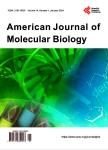Ca<sup>2+</sup>-Induced Conformational Change of Troponin C from the Japanese Pearl Oyster, <i>Pinctada fucata</i>
Ca<sup>2+</sup>-Induced Conformational Change of Troponin C from the Japanese Pearl Oyster, <i>Pinctada fucata</i>作者机构:Graduate School of Bioresources Mie University Tsu Japan
出 版 物:《American Journal of Molecular Biology》 (美国分子生物学期刊(英文))
年 卷 期:2018年第8卷第4期
页 面:205-214页
学科分类:1002[医学-临床医学] 100214[医学-肿瘤学] 10[医学]
主 题:Ca2+-Binding Catch Muscle Conformational Change EF-Hand Troponin C
摘 要:Troponin is a thin filament-associated regulator of vertebrate striated muscle contraction. Troponin changes its structure upon Ca2+ binding to troponin C, one of the subunits of troponin, allowing myosin to interact with actin. We recently elucidated the molecular characteristics of the Japanese pearl oyster Pinctada fucata troponin C (Pifuc-TnC), revealing the possibilities that Pifuc-TnC and vertebrate muscle TnC play dissimilar roles in muscle contraction. Pifuc-TnC has four EF-hand motifs, but, unlike vertebrate TnC, only one (site IV) was predicted to bind Ca2+. To confirm the number of Ca2+-binding sites in Pifuc-TnC and whether Ca2+ binding induces a conformational change, we purified the full-length protein and a variant, Pifuc-TnC-E142Q (that has a mutation in the predicted Ca2+-binding site of site IV), following their expression in laboratory E. coli. Isothermal titration calorimetry demonstrated Ca2+ binding to Pifuc-TnC, whereas Pifuc-TnC-E142Q was unable to bind Ca2+, confirming that site IV is the only Ca2+-binding site in Pifuc-TnC. Pifuc-TnC eluted in a later fraction from a gel filtration column in the presence of Ca2+ compared with the condition when Ca2+ was absent. In contrast, the elution profiles of Pifuc-TnC-E142Q were equivalent in both the presence and absence of Ca2+, suggesting that Ca2+ binding to Pifuc-TnC induces a conformational change that delays its elution from the column. UV-absorption spectral analysis revealed that binding of Ca2+ to Pifuc-TnC caused an increase in absorption at a wavelength of approximately 250 nm, possibly because phenylalanine residues had been exposed on the surface of the molecule as a result of a conformational change. Differential scanning calorimetric analyses of Pifuc-TnC showed aggregation in the presence of Ca2+ in accordance with an increase of temperature, but no aggregation was seen in the absence of Ca2+. In combination, these findings suggest that Ca2+ binding to site IV induces a conformational



